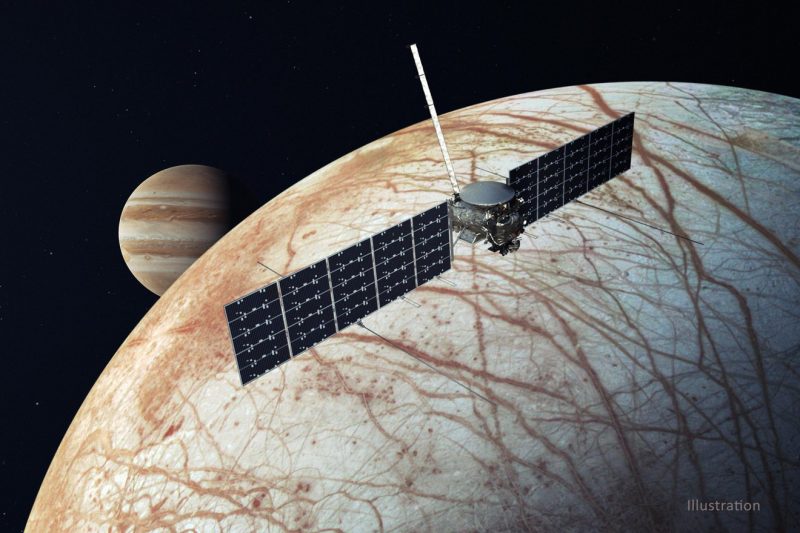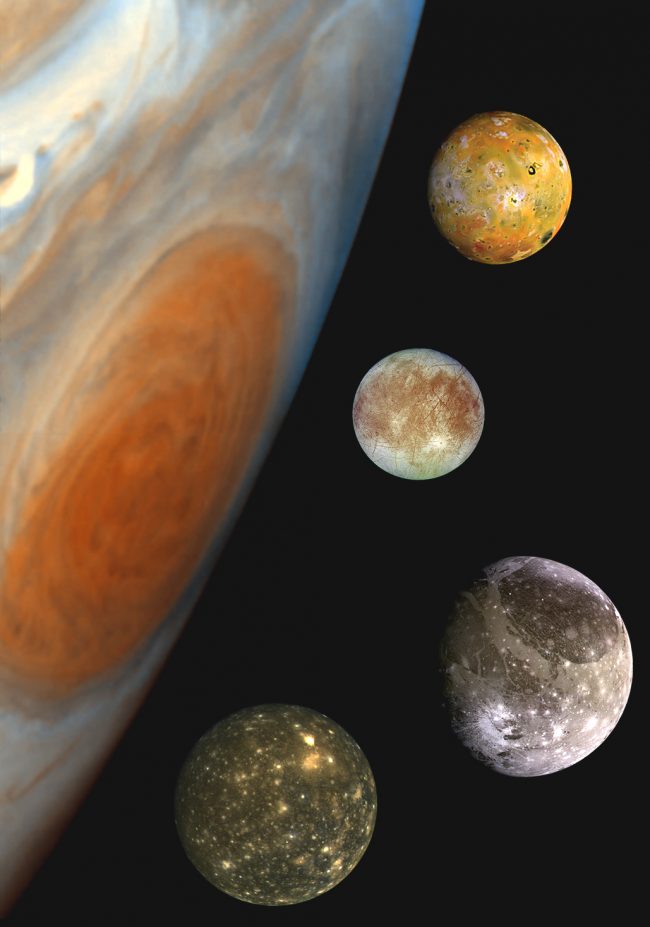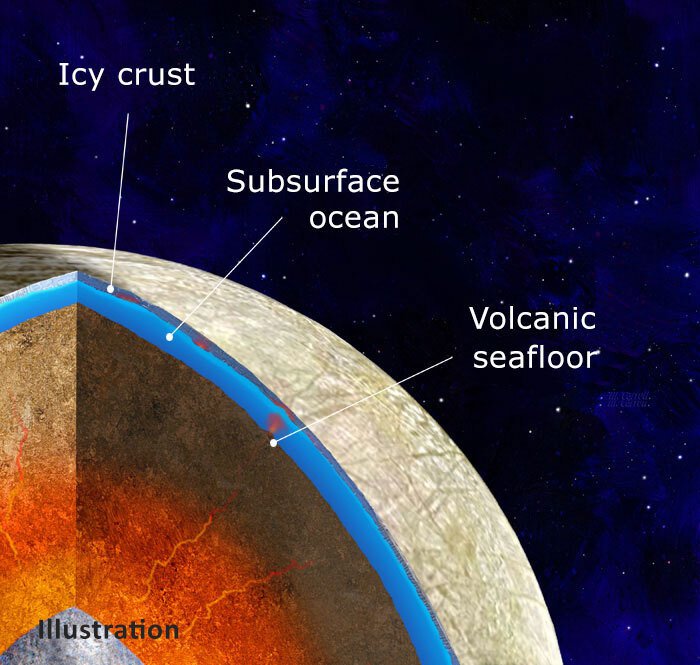
Jupiter’s icy, ocean-covered moon Europa might have active seafloor volcanoes pulsing just out of sight. A May 25, 2021, statement from NASA’s Jet Propulsion Laboratory in Pasadena, California, said that new research and computer modeling suggest the volcanoes. If they exist, NASA’s planned mission to this moon of Jupiter – the Europa Clipper mission – might be able to detect them.
Scientists published their research on this subject on December 22, 2020, in the peer-reviewed journal Geophysical Research Letters.
The results come from detailed 3D modeling, showing how Europa’s internal heat is produced and transferred.

Europa is Jupiter’s water world
Europa is the smallest of Jupiter’s four Galilean moons. It’s nearly the same size as Earth’s moon. Europa is the smoothest body in the solar system, smoother on a planetary scale than a billiard ball. Scientists believe Europa’s smoothness is due to a large ocean underneath its water-and-ice crust. Beneath the floor of that ocean, scientists believe, Europa might be hot enough to produce seafloor volcanoes.
And, if they exist, the scientists say, these undersea volcanoes on Europa might create an environment conducive to life.
Scientists confirmed volcanic activity on Io, the closest of the Galilean moons to Jupiter, decades ago. Io is famous for its active volcanoes. In fact, Io is the most volcanically active object in our solar system!
The active volcanoes on Io have a profoundly different source from earthly volcanoes. They’re due to Io’s nearness to Jupiter, whose powerful gravity stretches and squeezes the little moon. Io lies only 262,000 miles (422,000 km) from Jupiter. Europa lies 414,000 miles (670,900 km) from the gas giant.
Is Europa, too, being squeezed by Jupiter enough to create active volcanoes, on the floor of its hidden ocean?

Active seafloor volcanoes on Jupiter’s moon
Scientists, led by Marie Behounková of Charles University, created a computer model of Europa’s rocky interior. Earlier research had suggested that, like Earth, Europa has a an iron core, a rocky mantle and an ocean of salty water. Behounková and colleagues wanted to see how much Jupiter’s gravitational pull flexes Europa’s interior.
Just as when you bend a paperclip back and forth until it’s hot to the touch, so Jupiter manipulates Europa. The flexing in Europa’s inner mantle forces energy into the moon’s interior, which then seeps out as heat. The modeling shows where heat dissipates. It’s concentrated near Europa’s poles where the heat produced by tidal friction is greatest. The model also suggested that Jupiter’s manipulation melts Europa’s rocky mantle. Melting in the mantle would increase the likelihood of volcanoes on Europa’s seafloor.
Volcanoes are energy sources. On Earth’s seafloor, life thrives near hot-water volcanic vents. These earthly underwater volcanoes provide chemical energy that replaces sunlight, letting life flourish deep in the oceans, where no light can reach. As part of this new study, scientists examined the possible evolution of Europa’s volcanoes. How long might the volcanoes have been there, if they exist? Long-lived volcanoes on Europa might allow life to develop. Behounková commented:
Our findings provide additional evidence that Europa’s subsurface ocean may be an environment suitable for the emergence of life. Europa is one of the rare planetary bodies that might have maintained volcanic activity over billions of years, and possibly the only one beyond Earth that has large water reservoirs and a long-lived source of energy.
Europa Clipper mission
The Europa Clipper mission is tentatively scheduled to launch in 2024 and to arrive in Jupiter’s vicinity in 2030. The spacecraft will fly by Europa repeatedly, analyzing its atmosphere and surface, looking for plumes of water or ejected particles that might have come from the moon’s seafloor.
In addition, measurements of Europa’s gravity and magnetic field and any anomalies – particularly near the poles – might help confirm the predicted volcanic activity. Europa Clipper project scientist Robert Pappalardo of NASA’s Jet Propulsion Laboratory said:
The prospect for a hot, rocky interior and volcanoes on Europa’s seafloor increases the chance that Europa’s ocean could be a habitable environment. We might be able to test this with Europa Clipper’s planned gravity and compositional measurements, which is an exciting prospect.
Discovering whether Europa can support life will take us one step closer to understanding where in the greater universe life might exist.
Bottom line: The Europa Clipper mission might confirm new research that shows seafloor volcanoes on Jupiter’s ocean-covered moon, which could harbor life.
Source: Tidally Induced Magmatic Pulses on the Oceanic Floor of Jupiter’s Moon Europa











